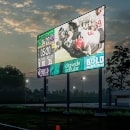Demanding the Best LED Displays Begins with Quality Diodes
If you want to ensure you are using a high quality LED display, it's important to make sure it has high quality LED diodes.
A light emitting diode, (LED) is the thing on your LED display that emits light. There are multiple types of led diodes, and they can be found in all kinds of led light products, including an LED bulb, led displays, your phone screen, outdoor lighting, etc.
LEDs are categorized as a semiconductor light source. Forward voltage from its power source makes the electrons in a diode combine at a P N junction in the diode. The energy generated is then released to make light.
LEDs are different from an incandescent bulb. In fact, they aren't the same at all! Where a typical light bulb has filaments that glow to emit light, an LED diode creates light via the flow of electrons in the diode.
An LED lamp will require much less energy and power than lighting made with traditional light bulbs. They also have a much longer life span and more diverse applications, which is why they're found so widely across electronics today.
Types of LED Diodes
There are different types of LED diodes, all with different benefits depending on the kind of lighting you are looking for. Let's break them down:
Through Hole LEDs: These are super common LED diodes that you would find in a wide range of products and devices. They come in multiple configurations, sizes, and colors, including red led, blue led, yellow led, green led, or white led. These typically look like small, round bulbs attached two two metal prongs.
SMD LED: A surface mount light emitting diode is an LED diode that is small and flat, designed to mount flush on a flat surface. These tend to look like small, glass rectangles.
Bi-Color LED: These are LED diodes that can display two different colors. They are similar in appearance to a through hole LED, though their small bulb is usually clear.
RGB LED: These are the most common LED diodes that display RGB colors, found in all kinds of displays. Again, these look similar to through hole LED diodes, with a clear glass bulb. These diodes, though, are connected to a pulse width modulation chip (PWM) that works to control the light's RGB light output, to form all kinds of colors.
High Power LED: A high powered LED is similar to other LEDs on our list, but they are brighter as they have more power. These LED diodes will have a power rating that is larger than a single WATT, much larger than the other diodes on our list. You'll find these in things like flashlights, or spotlights.
Maintaining LED Diodes
As with all kinds of lighting and tech, your LED diodes will eventually require some maintenance or replacement. Over time, led technology with diodes will lose its intensity and its light source quality will diminish.
It will occur in all electronic signs, but the effects can be worse for some manufactured LED signs than others. After the first 2000 hours of use, a diode will lose about 20% of its initial brightness on its emitted light. It then degrades at a slower rate until its life expectancy is reached at about 100,000 hours of use (about 10 years).
Some LED lighting can prematurely “age” because of the use of different diode manufacturers on a single display, causing uneven colors and shades. Other times they will burn out and have to be replaced because of cheap or inferior diodes and component parts used in the manufacturing process.
Another super common issue with LED diodes is having an incorrect electronic wavelength, due to its country of origin. Depending on where your LED diode was manufactured, the manufacturer will have different quality standards in mind. The electronic wavelength tolerance in one country can differ from another, compromising a diode's performance quality.
To avoid these kinds of issues, ensuring your display was made with consistent, high quality diodes is a must.
LED Diode Manufacturers
Diode research and development is focused on miniaturization, low-power consumption, higher integration, and compact packaging. Cost-effective production is a major competitive factor in the diode manufacturing business.
The three biggest companies manufacturing diodes are Cree, in North America, Nichia, in Japan, and Everlight, in Taiwan. These main suppliers are the best because they have the highest, most dependable quality control in the industry.
However, as excellent as these companies are, Ultravision LED Solutions raises the bar on LED diode standards. This comes down to what Ultravision LED Solutions uses in its LED displays that customers do not receive from other companies.
What makes Ultravision LED Solutions the best?
There are several reasons why the LED displays, digital video scoreboards, and billboards from Ultravision LED Solutions are better.
Firstly, we use surface mount diodes in our products, for their low power consumption, compact configuration, and exceptional wavelength. This results in superior light projection, brightness, and image quality on any kind of LED display.
Ultravision LED Solutions also purchases their diodes in specific bins of diodes with similar brightness and light energy. This is done to ensure a seamlessly functional product. Buying diodes this way is similar to buying carpeting in the same run or paint in the same batch. It makes for more brightness uniformity on your LED display.
Ultravision LED Solutions never uses diodes from two different manufacturers on the same panel display. The signs of incongruent diode performance, flashing led diodes, different hues of visible light, unwanted pink-looking casts, and inconsistent images, will all be avoided.
Why would anyone consider anything less than the highest value LED products from Ultravision LED Solutions? Be sure to keep Ultravision LED Solutions in mind if you are ever in the market for an LED display!










